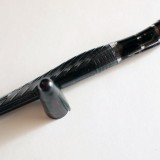Software for Writers: Liquid Story Binder XE
Liquid Story Binder XE is one of the few pieces of for-pay software for writers that I think is worth its salt. Mac users have their Scrivenir, which is beautiful and seems perfect for writers, but I don’t have a Mac and so I don’t have Scrivener. Liquid Story Binder (LSB from here on) is the next best thing for those of us stuck (by choice or circumstance) in the Windows world.
To say that LSB is a novel-writing program hardly scratches the surface of what the program does. To be frank, the program does so much that I’m not even entirely sure what it does! Let’s start with the metaphor of a binder. In a pen-and-paper world, a writer might put together a binder with all the information they’d need about their book-in-progress: character sketches, plot outlines, setting notes, drawings, random thoughts, todo lists, and so on.
Once you get the ideas behind it, LSB essentially offers a digital version of the paper binder, integrated with a workspace where you actually write your novel.
Or your not-novel. While LSB is clearly designed with fiction writers in mind, it is easily adaptable to any sort of prose, from short essays to non-fiction monographs. Character forms can be used to store information about sources or historical figures, setting forms can be used for place descriptions, and so on. In fact, for the essayist or short story writer who may want to compile their work into a book down the line, LSB is ideal — each chapter (or essay or story) is stored as a separate file (in Rich Text Format, which can be opened by virtually any word processor on any system) so it can be manipulated on its own, but when it comes time to collating everything together, LSB automates the process completely.
LSB also includes some other nice features, like the ability to create playlists to use while writing (consider this: a “heroic music” playlist for action scenes, a “romantic idylls” playlist for romance scenes, and a playlist composed entirely of Prince songs for sex scenes — you can soundtrack your own book while you write!) and reference works like a dictionary and thesaurus.
LSB comes with an example “Book” (its jargon for everything related to a single project) that includes examples of every function and tutorials on how to get started (which are complemented by some nice tutorials on their site). I had originally planned to do a walkthrough of the book creation process, but Tom Colvin of Becoming a Writer Seriously has already written a good introduction to Liquid Story Binder that covers most of the ground I would have.
Though it has a pretty steep learning curve, which the tutorials go a long way but not all the way towards alleviating, LSB is a worthwhile investment for any writer. I’d suggest getting it at the start of a project, so you don’t have to deal with cutting-and-pasting existing material into LSB and can focus instead on working with the program’s workflow. At $45.95 US, LSB isn’t cheap, but it’s nowhere near as expensive as much of the lesser software out there that promises to make writing easy. LSB makes no such promise; it only aims to make writing more organized.
Liquid Story Binder XE ($45.95 US)






I’ll follow your link to Tom’s site to see what he has to say, but I found my afternoon with Liquid Story Binder XE mind-boggling to say the least.
Why I would want writing software to house a playlist of music to listen to while I wrote is beyond me. It’s sorta neat, but it’s still beyond me. I have mp3 players for that.
To me XE seemed like very personal software that the author thought others might like because he enjoyed it and found it useful. I’m sure the long-tail works wonders in this regard, but without a handholding walk through I’m afraid I’d never get much of an ‘ah ha!’ moment. I’ve since uninstalled the demo.
I just wanted to add my recommendation for LSB. I don’t think I could be any more in love with it if my own kid invented it! Anyone who owns it should definitely join the Yahoo group; Jesse is so dedicated to helping us use the program to its full potential, and is always up to suggestions for new developments 😀
Douglas: I agree that LSB can be daunting. There’s something to what you say — that choice of software is going to be, ultimately, a very personal decision, like any artist and her or his tools. There are some painters who prefer one kind of brush, others that prefer another — I very much doubt writers are any less fussy.
For the kind of writer who is comfortable in the kind of self-contained environment LSB provides, I think it’s an amazing piece of work and the learning curve is worth it. Others are happy with something like Q10, plain text on a plain background and no frills.
I also wanted to add that like Douglas, I found LSB to be very intimidating at first. I, too, ended up deleting the software after a few days for the same reasons. However, I came back and tried it again, studied the screen images on the LSB site, joined the Yahoo group, and spent a LOT of time in the sample book that comes with the program. I feel like I’ve got it whipped now. I am a very visual and hands on learner, so those methods worked for me but may not for others.
Something else that helped me was to look at the Scrivener software site (how I wish I had a Mac, if only for that software!) to see what features it had, then looked at what LSB has that would be comparable. IMO, the time it took to learn more about it was so worth it, because now I’m not as disorganized with my writing as I was before.
I tried LSB and also ended up removing the software.
Great eye candy, but after a few days of fiddling with it, I decided I wanted to write and not (endlessly) tweak my software to get it “just right.”
It seemed like the developer was slamming back Red Bulls, writing for his blog, designing a website, playing a MMORPG game, listening to his favorite band and reading an online Manga comic book all at the same time while writing the code for LSB.
I was looking for something more than q10 but LSB was overkill in the extreme.
I did find a nice solution finally. It does everything I need very well, doesn’t choke me with eye candy and features I’ll never use while being cheaper to boot.
@aaron What did you find?
I’ve been playing with Celtx which appears to be very Scrivener-like and for the PC. Near as I can tell without having a Mac.
“It seemed like the developer was slamming back Red Bulls, writing for his blog, designing a website, playing a MMORPG game, listening to his favorite band and reading an online Manga comic book all at the same time while writing the code for LSB.”
@aaron Meant to add: “Amen to that!”
@Douglas
I found a great software (PC only) called PageFour.
It is relatively inexpensive word processor ($29.99) that just processes word, not tables, pictures, charts. It doesn’t tell you how to start writing your novel, doesn’t give you “hints” and suggestions. No character bios. No built in MP3 player.
It is classy, clean and simple. There is a free 30 day trial period.
*I am not affiliated with PageFour except as a user who happens to think it is the best writing app for writers there is.*
Feel free to e-mail me off list if you can’t find it
ajwalker at live dot com
As Dustin already mentioned a few comments earlier, every author is different and has different requirements. While LSB may be daunting and “overkill” to some, it’s just right for others.
Like many, I installed it and rather than uninstall it, let it sit forgotten because it was intimidating. I didn’t want to take the time to learn it or understand it.
A little while later (like 6 months), I came back to it and started learning it little by little. The “Quick Start Guide” was essentially all I needed to start organizing and writing. I didn’t use any of the other features (i.e. dossier, manuscript builder, etc.) for the first 3 months. In fact, I still haven’t used the playlist feature, but am currently setting that up. But, as I became more comfortable writing with the software, it suddenly opened itself up to me and became easier to wrap my mind around. And as I began setting up dossiers, project goals, and the like, my writing life became more productive.
Why the life story? I simply wanted to illustrate that thought and care was put into each of the software’s features. Not quite sure how you work, but I enjoy looking at pictures, having readily available character bios, and listening to music while I write because it helps inspire me and keeps me inspired.
LSB is about creating the ultimate creative writing environment. Rather than needing to minimize the program so that you can futz with your computer’s music player, or open up a picture viewer, or other reference material, the creator provided all of that within LSB itself. You can pretty much sit back, write, and forget that other programs on your computer exist.
It’s not really fair to infer that LSB is not classy or good software for writers because you don’t understand the line of reasoning for a feature. And on a parting note, just because a program has a specific feature doesn’t mean you have to use it. 😉
In any event, glad you found something that suits your needs. Keep writing and much success to you.
-BM